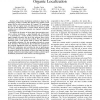Free Online Productivity Tools
i2Speak
i2Symbol
i2OCR
iTex2Img
iWeb2Print
iWeb2Shot
i2Type
iPdf2Split
iPdf2Merge
i2Bopomofo
i2Arabic
i2Style
i2Image
i2PDF
iLatex2Rtf
Sci2ools
102
Voted
INFOCOM
2011
IEEE
2011
IEEE
Implications of device diversity for organic localization
—Many indoor localization methods are based on the association of 802.11 wireless RF signals from wireless access points (WAPs) with location labels. An “organic” RF positioning system relies on regular users, not dedicated surveyors, to build the map of RF fingerprints to location labels. However, signal variation due to device heterogeneity may degrade localization performance. We analyze the diversity of those signal characteristics pertinent to indoor localization — signal strength and AP detection — as measured by a variety of 802.11 devices. We first analyze signal strength diversity, and show that pairwise linear transformation alone does not solve the problem. We propose kernel estimation with a wide kernel width to reduce the difference in probability estimates. We also investigate diversity in access point detection. We demonstrate that localization performance may degrade significantly when AP detection rate is used as a feature for localization, and correlate t...
| Added | 30 Aug 2011 |
| Updated | 30 Aug 2011 |
| Type | Journal |
| Year | 2011 |
| Where | INFOCOM |
| Authors | Jun-geun Park, Dorothy Curtis, Seth J. Teller, Jonathan Ledlie |
Comments (0)

